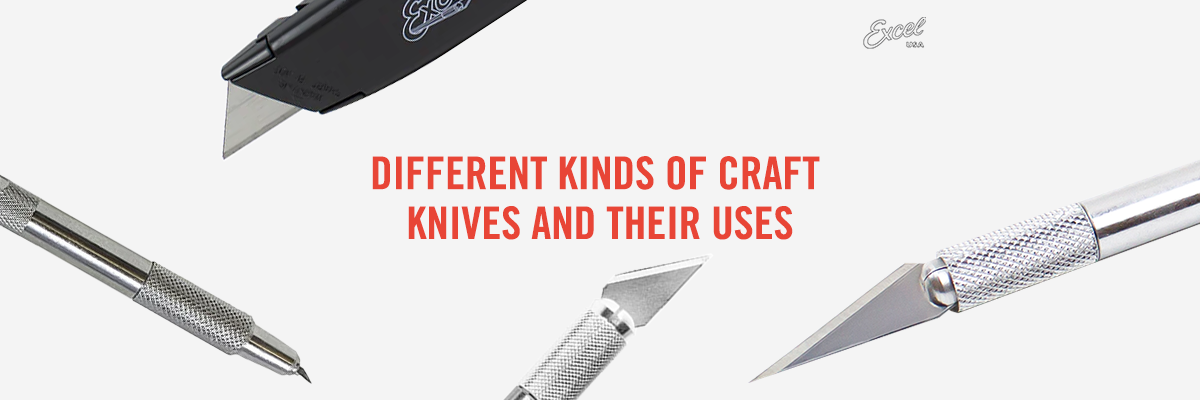
Types of Craft Knives and Their Uses
Different Kinds of Craft Knives and Their Uses
Your all-in-one guide to choosing the right blade for any craft project
Craft knives—also known as hobby knives, precision knives, or utility knives—are essential tools for crafters, hobbyists, and professionals alike. But with so many types available, how do you choose the right one for your project? In this in-depth guide, we’ll walk through:
- Types of craft knives & blade profiles
- Materials commonly worked with
- Step-by-step application examples
- Buying tips (blade type, handle, safety)
- Maintenance & safety advice
Whether you're trimming paper for stencils or sculpting foam, you'll finish this guide confident in your blade choice—ready to elevate your crafting.
Types of Craft Knives & Blade Profiles
1. Utility Knives – All-Purpose Power Tools
What They Are: General-purpose with retractable blades for convenience and safety.
Common Blades & Uses
- Trapezoid: Excellent for box cutting, rail and carpet slicing
- Hook blades: Cut roofing materials, linoleum flooring
- Concave blades: Ideal for vinyl graphics and wallpapers
Example Use Case: Foam Core School Model
Step-by-step:
- Score lightly with a utility knife
- Make multiple passes to go deeper
- Final cut in one smooth motion.
You’ll get cleaner edges and fewer splinters with each pass.

2. Precision Knives (e.g., X‑Acto Style)
What They Are: Slim, replaceable-blade handles for detailed work.
Common Blades & Uses
- #11: Fine point — perfect for paper cutting and scoring
- #2: Larger fine point — suited for vinyl decals
- #6 (micro‑stencil): Tiny curved blades for ultra‑fine cutting
Step-by-Step: Stencil Creation
- Draw or print your design
- Place stencil backing under paper
- Use a #11 blade to trace all curved edges
- Rotate paper, not your knife, for smooth cuts

You May Also Watch: Why Every Crafter Needs the #11 Craft Blade
3. Swivel Knives – Smooth Curves Made Easy
What They Are: Blades housed in rotating heads — perfect for freehand cuts and circular shapes.
Best Applications
- Decorative foam designs
- Leather tooling
- Circular routing on foam board
Step-by-Step: Foam Wonderland
- Sketch your design
- Position the swivel blade at start point
- Rotate to follow line continuously
- Lift and repeat for second pass

You May Also Watch: How to Use a Swivel Knife
Types Include
- Chip-carving knives (diagonal bevel)
- Detail knives (rounded or flat edge)
- Hook knives for concave scooping
Ideal Tasks
- Wood reliefs, miniatures carving, leatherwork
- Carving hollows and contours
Step-by-Step: Wood Relief Panel
- Mark design with carbon paper
- Use detail knife to outline
- Carve away background with chip-carving tool
- Sand smooth for clean finish

5. Heavy-Duty & Specialty Knives
When You Need Them
Cutting thick materials: linoleum, heavy foam-core, mat boards, fabrics
Common Designs
- Rugged fixed-blade utility knives
- Heavy-duty hobby knife handles
Step-by-Step: Heavy Cardboard Kit
- Score perimeter three times
- Clean corner edges last
- Use new blade for cleaner results

You May Also Watch: Excel Blades Dual Strip Cutter for Quilling
6. Composite & Specialty Knife Types
Includes scalpel-style handles, rotary cutters, and glass-blade knives.
Uses: Biological dissection, leather scalloping, fine trimming on fabric or vinyl.
Match Knife Types with Materials
|
Material |
Suggested Knife/Blade |
Why |
|
Paper |
#11 precision |
Sharp lines, clean cuts |
|
Vinyl/decal |
Utility hook + precision |
Vinyl cuts + detail trimming |
|
Foam core |
Heavy-duty |
Control and clean slicing |
|
Leather |
Swivel or hook knife |
Seam contour cutting |
|
Wood relief |
Chip/carving knives |
Precise carve control |
Buying Guide: Choosing the Right Knife
Blades
- Fine-point for paper & vinyl
- Hook for vinyl/fabric
- Heavy for foam & wood
Handles
- Metal for weight/stability
- Plastic for comfort
- Ergonomic for long-term use
Safety Features
- Retractable blades
- Secure locking systems
- Protective caps
Excel Blades Recommendations
- K1 Precision Knife – Best for general hobby use
- K18 Cushion Grip Knife – Ideal for heavier-duty slicing
- K71 Index Finger Knife – For precision detail work
- K26 Fit Grip Knife – Ergonomic design for long hours of crafting
- K31 Adjustable Dual Blade Strip Cutter – Best for even strips and cuts
8. Maintenance & Safety Tips
- Always cap or retract your blade
- Replace blades when dull
- Use cutting mats
- Store blades and handles separately
- Dispose of used blades properly (sharps container)
9. Real-World Starter Projects
A. Paper Lantern: Use #11 precision blade to cut window designs—stencil before cutting
B. Foam Diorama: Score foam with deep passes then craft contours
C. Leather Bookmark: Use hook knife for shaping curves, finish edges with sandpaper
Understanding the different kinds of craft knives unlocks precision and efficiency. The right handle and blade combo—whether precision, utility, swivel, or carving knife—can elevate your results. Explore more blades and handles at Excel Blades Specialty Tools.
You May Also Watch: Excel Blades K71 Index Finger Knife